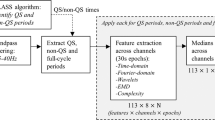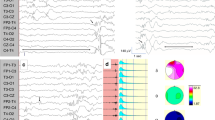Abstract
OBJECTIVE:
Amplitude-integrated electroencephalogram (aEEG) is a single channel EEG recorded from two parietal electrodes. The objective of this study was to test the hypothesis that aEEG maturation follows postmenstrual age (PMA) irrespective of gestational age (GA).
METHODS:
We recruited inborn infants with a GA <33 weeks and without evidence of neurologic anomaly. Serial aEEG recordings were assessed for: presence of continuous activity and mature sleep-wake cycling (SWC); low base voltage (V), that is, the lowest amplitude margin; high base V, that is, the most common amplitude margin; upper high V, that is, upper margin during highest activity; and span, that is, the difference between upper high and simultaneous high base V. Statistical analysis included logistic regression and repeated measures analysis of variance.
RESULTS:
We obtained 119 aEEG recordings in 31 preterm infants (GA 25 to 32 weeks; birth weight 600 to 1704 g, PMA 25 to 35 weeks). The frequency of mature SWC increased with PMA independent of GA, while the frequency of continuity increased with PMA and was higher in extremely preterm infants after correcting for PMA. Low base and high base V increased with PMA, while span and upper high V significantly decreased with PMA. In addition, high base V was higher in extremely preterm infants after correcting for PMA.
CONCLUSIONS:
In preterm infants aEEG matures predominantly with PMA. Our data suggest that some aspects of aEEG maturation are enhanced, rather than inhibited by extremely preterm birth. These data suggest that aEEG in preterm infants may need to be analyzed by comparing results with standards of similar PMA and GA.
This is a preview of subscription content, access via your institution
Access options
Subscribe to this journal
Receive 12 print issues and online access
$259.00 per year
only $21.58 per issue
Buy this article
- Purchase on Springer Link
- Instant access to full article PDF
Prices may be subject to local taxes which are calculated during checkout




Similar content being viewed by others
References
Prior P . Why monitor and why. In: Prior P, editor. Monitoring Cerebral Function. Long-term Recordings of Cerebral Electrical Activity. Philadelphia, PA: JB Lippincott Company; 1979. p. 1–19.
Hellstrõm-Westas L, de Vries LS, Rosén I . An Atlas of Amplitude-integrated EEGs in the Newborn. London, UK: The Parthenon Publishing Group; 2003. p. 1–150.
Verma UL, Archbald F, Tejani NA, Handwerker SM . Cerebral function monitor in the neonate. I: normal patterns. Dev Med Child Neurol 1984;26:154–161.
Archbald F, Verma UL, Tejani NA, Handwerker SM . Cerebral Function monitor in the neonate. II: birth asphyxia. Dev Med Child Neurol 1984;26:162–168.
Hellström-Westas L, Rosen I, Svenningsen NW . Predictive value of early continuous amplitude integrated EEG recordings on outcome after severe birth asphyxia in full term infants. Arch Dis Child Fetal Neonatal Ed 1995;72:F34–F38.
Azzopardi D, Robertson NJ, Cowan FM, Rutherford MA, Rampling M, Edwards AD . Pilot study of treatment with whole body hypothermia for neonatal encephalopathy. Pediatrics 2000;106:684–694.
Shalak LF, Laptook AR, Velaphi SC, Perlman JM . Amplitude-integrated electroencephalography coupled with an early neurologic examination enhances prediction of term infants at risk for persistent encephalopathy. Pediatrics 2003;111:351–357.
Thornberg E, Ekström-Jodal B . Cerebral function monitoring: a method of predicting outcome in term neonates after severe perinatal asphyxia. Acta Paediatr 1994;83:596–601.
Groenendaal F, de Vries LS . Selection of babies for intervention after birth asphyxia. Semin Neonatol 2000;5:17–32.
Hellström-Westas L . Comparison between tape-recorded and amplitude-integrated EEG monitoring in sick newborn infants. Acta Paediatr 1992;81:812–819.
Greisen G . Tape-recorded EEG and the cerebral function monitor: amplitude-integrated, time-compressed EEG. J Perinat Med 1994;22:541–546.
Toet MC, van der Meij W, de Vries LS, Uiterwaal CS, van Huffelen KC . Comparison between simultaneously recorded amplitude-integrated electroencephalogram (cerebral function monitor) and standard electroencephalogram in neonates. Pediatrics 2002;109:772–779.
Hellström-Westas L, Rosen I, Svenningsen NW . Cerebral function monitoring during the first week of life in extremely small low birthweight (ESLBW) infants. Neuropediatrics 1991;22:27–32.
Connell JA, Oozeer R, Dubowitz V . Continuous 4-channel EEG monitoring: a guide to interpretation, with normal values, in preterm infants. Neuropediatrics 1987;18:138–145.
Burdjalov VF, Baumgart S, Spitzer A . Cerebral function monitoring: a new scoring system for evaluation of brain maturation in neonates. Pediatrics 2003;112:855–861.
al Naqeeb N, Edwards AD, Cowan FM, Azzopardi D . Assessment of neonatal encephalopathy by amplitude-integrated electroencephalography. Pediatrics 1999;103:1263–1271.
Olischar M, Klebermass K, Kuhle S, et al. Reference values for amplitude-integrated electroencephalographic activity in preterm infants younger than 30 weeks’ gestational age. Pediatrics 2004;113:e61–e66.
Hayakawa M, Okumura A, Hayakawa F, et al. Background electroencephalographic (EEG) activities of very preterm infants born at less than 27 weeks gestation: a study on the degree of continuity. Arch Dis Child Fetal Neonatal Ed 2001;84:F163–F167.
Viniker DA, Maynard DE, Scott DF . Cerebral function studies in neonates. Clin Electroencephalogr 1984;15:185–192.
Kuhle S, Klebermass K, Olischar M, et al. Sleep-wake cycles in preterm infants below 30 weeks of gestational age. Preliminary results of a prospective amplitude-integrated EEG study. Wien Klin Wochenschr 2001;113:219–223.
Thornberg E, Thiringer K . Normal pattern of the cerebral function monitor trace in term and preterm neonates. Acta Paediatr Scand 1990;79:20–25.
Hellström-Westas L, Klette H, Thorngren-Jerneck K, Rosen I . Early prediction of outcome with aEEG in preterm infants with large intraventricular hemorrhages. Neuropediatrics 2001;32:319–324.
Maynard DE . Technical aspects. In: Prior P, Maynard DE, editors. Monitoring Cerebral Function. Long-term Recordings of Cerebral Electrical Activity. Philadelphia: JB Lippincott Co.; 1979;p:21–43.
ter Horst HJ, Brouwer OF, Bos AF . Burst suppression on amplitude-integrated electroencephalogram may be induced by midazolam: a report on three cases. Acta Paediatr 2004;93:559–563.
Bell AH, Greisen G, Pryds O . Comparison of the effects of phenobarbitone and morphine administration on EEG activity in preterm babies. Acta Paediatr 1993;83:35–39.
Thomas JR, Nelson JK, Thomas KT . A generalized rank-order method for nonparametric analysis of data from exercise science: a tutorial. Res Quart Exerc Sport 1999;70:11–23.
Eeg-Olofsson O . Longitudinal developmental course of electrical activity of brain. Brain Dev 1980;2:33–44.
Als H, Duffy FH, McAnulty GB, et al. Early experience alters brain function and structure. Pediatrics 2004;113:846–857.
Dreyfus-Brisac C . Ontogenesis of sleep in human prematures after 32 weeks of conceptional age. Dev Psychobiol 1970;3:91–121.
Curzi-Dascalova L, Figueroa JM, Eiselt M, et al. Sleep state organization in premature infants of less than 35 weeks’ gestational age. Pediatr Res 1993;34:624–628.
Acknowledgements
We wish to thank Ted Weiler, Ph.D., for his support and expert advice, and Olympic Medical for an unrestricted instrument grant, which provided us with a CFM 5330 for the duration of the study. Preliminary results were published in abstract form: J Invest Med 2003;51(Suppl 2): S422 and Pediatr Res 2003;53:448A, and presented at the Annual Meeting of the Eastern Society for Pediatric Research at Old Greenwich, CT, 3/22/03 and at the Annual Meeting of the Society for Pediatric Research at Seattle, WA, 5/6/03.
Author information
Authors and Affiliations
Additional information
S.J. is currently affiliated with Children's Hospital at Albany Medical Center, Albany, NY, USA.
Rights and permissions
About this article
Cite this article
Sisman, J., Campbell, D. & Brion, L. Amplitude-Integrated EEG in Preterm Infants: Maturation of Background Pattern and Amplitude Voltage with Postmenstrual Age and Gestational Age. J Perinatol 25, 391–396 (2005). https://doi.org/10.1038/sj.jp.7211291
Published:
Issue Date:
DOI: https://doi.org/10.1038/sj.jp.7211291
This article is cited by
-
Sleep state organisation of moderate to late preterm infants in the neonatal unit
Pediatric Research (2023)
-
A practical approach toward interpretation of amplitude integrated electroencephalography in preterm infants
European Journal of Pediatrics (2022)
-
The effects of betamethasone on the amplitude integrated EEG of infants born at 34- or 35-weeks gestation
Journal of Perinatology (2022)
-
Predictive value of early amplitude integrated electroencephalogram (aEEG) in sleep related problems in children with perinatal hypoxic-ischemia (HIE)
BMC Pediatrics (2021)
-
Early aEEG can predict neurodevelopmental outcomes at 12 to 18 month of age in VLBWI with necrotizing enterocolitis: a cohort study
BMC Pediatrics (2021)



